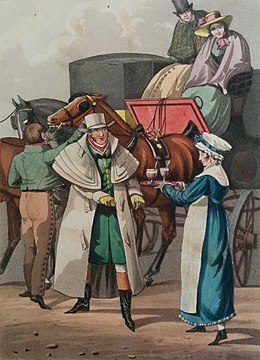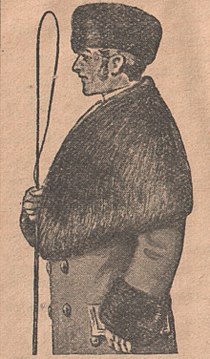Driver's collar
The coachman's collar is a cape-like collar shape on women's and men's coats. The collar completely covers the shoulders, it is much larger than the additional roof collar. Winterly trimmed with fur , the driver's collar forms a broad and massive men's coat collar that falls over the shoulders and is provided with strong fur. Historically, it is part of the coachman's coat as it was worn by stately coachmen as protection from the weather . Another characteristic of the original shape is that the fabric collar consisted of two or more individual collars that became smaller in each layer above.
history
August Friedrich Ernst Langbein described in his “Prosaische Werken” in 1837 a “brown robe whose six-fold driver's collar covered the back and even stretched to the edge of the deeper region, which one does not like to name,” and gave the owner the appearance of a Polish one Bear leader gave.
Before the advent of the automobile, when the rulers still used carriages, a particularly warm coat was essential in winter for the coachman or sleigh driver sitting in front in cold areas . At least for the passengers, additional warming footmuffs and fur blankets were often kept ready. The coat or, even more finely, the livery of the coachman should also represent the wealth of the owner appropriately. This could also be shown by the choice of collar material. If a layer of simple sheepskin was actually sufficient as protection against the cold, more noble “ smoke ” types of fur were often used. However, since special emphasis was placed on the striking opulence of the coachman's collars, skins from black and brown bears and skins from long-haired goats, so-called “bear goats” were used. The fur collar very often also included fur cuffs and possibly a fur hat. Worked as a “fur trim”, the collar and cuffs were removable, making the coat suitable for wear even on less wintry days.
The Leipzig fur wholesaler Friedrich Erler offered around 1900:
- Coach pelts in an appropriate shape, with good lambskin lining 90 to 120 marks
- Driver's collar
- Driver's hats , in fox , raccoon , 15 to 30 marks.
Other more valuable, popular fur materials for professional and earlier civilian driver's collars were wolf pelts and the stronger qualities of the mostly flat-haired raccoon pelts and skunk pelts .
The "driver set pictured consisting of fur collar, hat and gloves from the best, very dark Heidschnucken made drumheads act such sets very elegant and fancy." ( Soltau , 1903)
Coach set of the Breslau furrier M. Boden (1917)
Manufacture of the fur trim
For the production of the large fur collars, also known as coachman collars, in civilian fashion, the usual furrier working methods for the individual types of fur must be used .
In 1895, master furrier Heinrich Hanicke from Leipzig described the production from black and "now and then also brown bears" into "elegant and, by the way, extremely durable coachman sets" which were very popular (see working sketch):
- “In plate 8 an example is given of making collars and cuffs from one hide. If this type of processing also seems a bit complicated, some interested parties will soon be happy to make friends with it. The pump is here, as the fur itself almost indicates, used to the front parts, while the middle part with the help of the incidental waste forms the back part. Finally, the cuffs have been removed from the thick leather neck and head piece. At the neckline, it is advisable to make a narrow stand-up collar from the densest waste; the same is always preferable to a simple edging, it provides more protection and is resistant to friction. Not too exposed to wear and tear. "
Paul Cubaeus, “a practical furrier in Frankfurt am Main”, explained to his colleagues in 1891 the process of finishing a collar to be worn loosely as follows: “Large driver's collars resembling pelerines are made in the same way as women's pelerinas, only that they are lined with cloth. They must be covered with strong canvas and fastened on the front part, where hooks and eyes, possibly passementery , are placed on them ”.
See also
Web links
Individual evidence
- ↑ Coachman's collar . In: Alfons Hofer: Textile and Model Lexicon . 7th edition. Volume 1. Deutscher Fachverlag, Frankfurt am Main 1997, ISBN 3-87150-518-8 , p. 491.
- ↑ Alexander Tuma: Coachman's collar . In: Pelz-Lexikon. Fur and rough goods . tape 19 . Alexander Tuma, Vienna 1950, p. 106 .
- ↑ Coachman's collar. In: Jacob Grimm , Wilhelm Grimm (Hrsg.): German dictionary . tape 11 : K - (V). S. Hirzel, Leipzig 1873, Sp. 2890 ( woerterbuchnetz.de ).
- ^ August Friedrich Ernst Langbein: Prosaic works . J. Scheible, Stuttgart 1837, p. 36.
- ^ Hermann Deutsch: The modern skinning. Manual for the furrier, dyer, bleacher, cutter and garment maker . A. Hartleben's Verlag, Vienna / Leipzig, 1930. p. 313.
- ^ Catalog of the Friedrich Erler company, Leipzig .
- ^ Prospectus from CA Herpich Söhne, Berlin, 1910–1911 , p. 16.
- ↑ Editor: Polecat, martens, otters and skunk remain marginal ranges . In: Pelz International , Issue 10, Rhenania-Fachverlag, Koblenz October 1948, p. 58.
- ↑ Heinrich Hanicke: Handbook for furrier . Published by Alexander Duncker , Leipzig 1895, p. 15.
- ↑ Paul Cubaeus: The whole of Skinning. Thorough textbook with everything you need to know about merchandise, finishing, dyeing and processing of fur skins . 1st edition. A. Hartleben's, Vienna, Pest, Leipzig 1891, p. 377 .





